How to Grow and Care for Tomatillos: Expert Tips and Tricks
- May 23, 2024
- 0 comment
Learn how to grow and care for tomatillos with expert tips and tricks. Achieve a thriving garden and bountiful harvest with our comprehensive guide. Growing tomatillos can be a rewarding experience for both novice and seasoned gardeners. These vibrant green fruits, encased in their signature husks, are a staple in many Mexican dishes and add a unique flavor to your culinary creations.
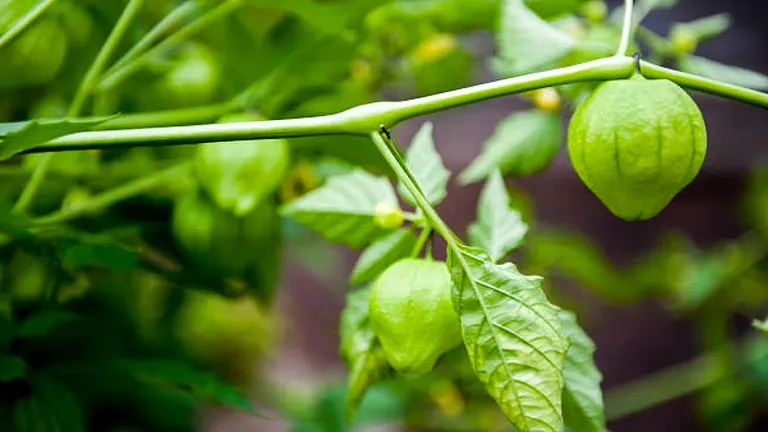
In this guide, we’ll provide you with expert tips and tricks on how to grow and care for tomatillos, ensuring a bountiful harvest and a flourishing garden. Whether you’re starting from seeds or transplanting seedlings, our step-by-step instructions will make the process easy and enjoyable.
Table of Contents
- Understanding Tomatillos
- Starting Your Tomatillos
- Planting and Spacing
- Daily Care and Maintenance
- Mulching and Weed Control
- Pruning and Training
- Pest and Disease Management
- Harvesting and Storing
- Troubleshooting Common Issues
- Conclusion
- FAQs
Understanding Tomatillos
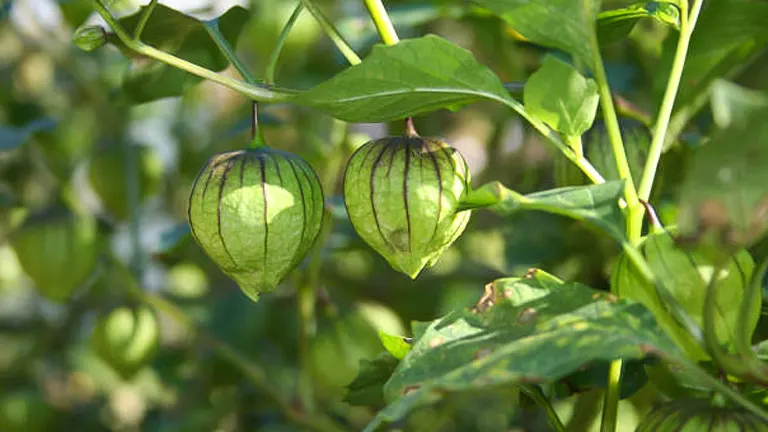
Tomatillos (Physalis philadelphica), also known as Mexican husk tomatoes, are an intriguing member of the Solanaceae family, closely related to tomatoes and peppers. These plants are characterized by their distinctive papery husk, which encases the fruit. This husk, initially green, transitions to a brown color as the fruit matures, indicating readiness for harvest. The fruit itself is usually vibrant green, though certain varieties exhibit unique purple or yellow hues upon maturity, each color variation typically indicating a slight difference in taste and acidity.
Here’s a closer look at some popular varieties:
- Verde Puebla: This variety is prized for its large, robust green fruits. Each fruit can weigh between 1.5 to 2 ounces and is often used in the preparation of traditional green salsas due to its bright, tangy flavor.
- Purple de Milpa: Known for its striking purple fruits, this variety is smaller, typically weighing around 1 ounce. It offers a sweeter and less acidic flavor, making it a favorite for raw consumption and decorative purposes.
- Gigante: True to its name, the Gigante variety produces significantly larger fruits, each weighing up to 3 ounces. These tomatillos are versatile in the kitchen, suitable for both salsas and cooked dishes.
Optimal Growing Conditions
Tomatillos are sun-loving plants that thrive under full sun exposure and warm conditions. They grow best in well-drained soils with a pH level ideally situated between 6.5 and 7.0, slightly acidic to neutral. These plants are remarkably resilient and adaptable to various environmental conditions but perform optimally when temperatures are maintained between 70°F to 85°F (21°C to 29°C). Below is a table summarizing the optimal growing conditions for tomatillos:
| Condition | Optimal Range |
|---|---|
| Sunlight | Full sun (6+ hours per day) |
| Soil pH | 6.5 to 7.0 |
| Temperature | 70°F to 85°F (21°C to 29°C) |
| Soil Type | Well-draining |
Tomatillos also require consistent moisture for proper fruit development, with a recommended water intake that slightly increases as the plants flower and fruit. Efficient water management is crucial, as both over and under-watering can lead to reduced fruit size and potential disease.
Starting Your Tomatillos
Seed Selection

The foundation of a robust tomatillo garden starts with high-quality seeds. It’s imperative to select seeds from reputable suppliers to ensure they are disease-free and boast high germination rates. When choosing seeds, gardeners have the option between organic and conventional seeds. Organic seeds are produced without synthetic chemicals and can be a preferable choice for those aiming to maintain an organic garden. Here are some factors to consider when selecting seeds:
- Germination Rate: Typically, a germination rate of 80% or higher is desirable.
- Seed Viability: Check for seeds that are less than a year old to ensure higher viability.
Seed Starting Indoors
In cooler climates or regions with shorter growing seasons, starting seeds indoors is crucial for a head start. Begin this process approximately 6 to 8 weeks before the last expected frost date. Here are step-by-step instructions:
- Container Preparation: Use small containers or seed trays filled with a sterile, light starter soil to avoid disease.
- Sowing Depth: Plant seeds at a depth of about 0.25 inches (6 mm), which has been scientifically shown to optimize germination.
- Moisture and Light: Keep the soil consistently moist but not waterlogged. Provide ample light, ideally from a grow light, to ensure seedlings grow strong and do not become leggy.
A table summarizing the indoor starting conditions can help visualize this process:
| Condition | Optimal Setup |
|---|---|
| Soil Type | Light, sterile starter soil |
| Lighting | 14-16 hours per day (grow lights) |
| Temperature | 70-78°F (21-25.5°C) |
| Moisture | Consistently moist, not waterlogged |
Transplanting Seedlings
Transplanting begins once the seedlings have developed a few sets of true leaves and the risk of frost has passed. To prevent transplant shock, a gradual acclimation to outdoor conditions is necessary, known as hardening off. This process involves:
- Duration: Start with 1-2 hours of outdoor exposure on the first day, gradually increasing the time spent outdoors over the course of a week.
- Environmental Exposure: Initially, place seedlings in a shaded, sheltered area to minimize stress. Gradually expose them to more direct sunlight and varying temperatures.
Planting and Spacing
Site Preparation
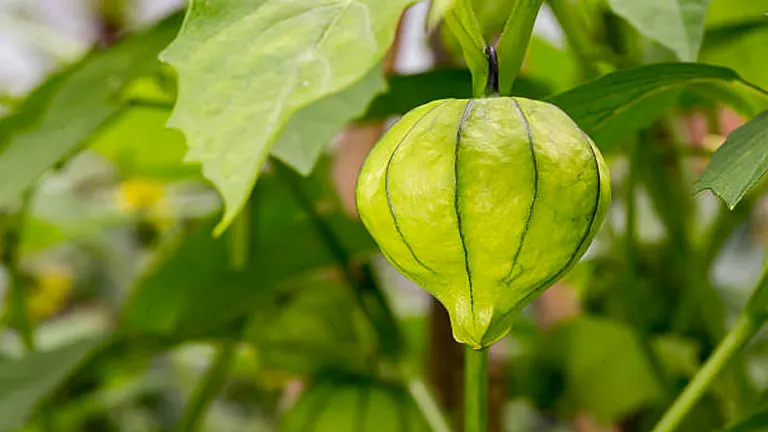
Preparing your garden site meticulously is critical for the successful cultivation of tomatillos. Start by removing all weeds and debris to minimize competition and reduce the risk of pest infestations. Enrich the soil by incorporating a generous amount of compost or a balanced fertilizer; this step is vital as tomatillos thrive in nutrient-rich, well-draining soil. Key soil amendments might include:
- Compost: Adds organic matter, improves soil structure, and enhances moisture retention.
- Balanced Fertilizer (e.g., 10-10-10 NPK): Provides essential nutrients that promote healthy growth and fruit development.
Planting Techniques
To ensure robust growth and optimal fruit production, follow these scientifically backed planting techniques:
- Hole Preparation: Dig holes that are twice the width of the root ball and slightly deeper. This allows the roots to spread easily, promoting better establishment and access to nutrients.
- Plant Spacing: Place tomatillo plants approximately 3 feet apart. Proper spacing is crucial for adequate air circulation around the plants, reducing the risk of fungal diseases such as blight and powdery mildew.
- Row Spacing: Space rows about 3 to 4 feet apart. This spacing is particularly important in medium to high-density orchards, as it facilitates easier access for maintenance and harvesting activities.
- Planting Depth: Set the seedlings so that the base of the stem is level with the surrounding soil surface. This positioning ensures that the stem doesn’t become buried, which could promote rot.
Here’s a table summarizing the planting details for easy reference:
| Aspect | Detail |
|---|---|
| Soil Preparation | Enrich with compost and balanced fertilizer |
| Hole Size | Twice the width and depth of the root ball |
| Plant Spacing | 3 feet apart |
| Row Spacing | 3 to 4 feet apart |
| Planting Depth | Stem level with soil surface |
Additional Tips:
- Mulching: After planting, apply a layer of organic mulch around the base of each plant. This not only helps retain soil moisture and regulate temperature but also suppresses weed growth. Suitable mulching materials include straw, shredded bark, or leaf mold.
- Watering: Initially, water the plants thoroughly to settle the soil around the roots and eliminate air pockets. Continue to water deeply once a week, adjusting frequency based on rainfall and temperature conditions.
- Staking: Consider staking or using cages for tomatillo plants as they grow. Supports help keep the plants upright and the fruits clean and away from soil contact, minimizing disease exposure.
Daily Care and Maintenance
Watering Requirements
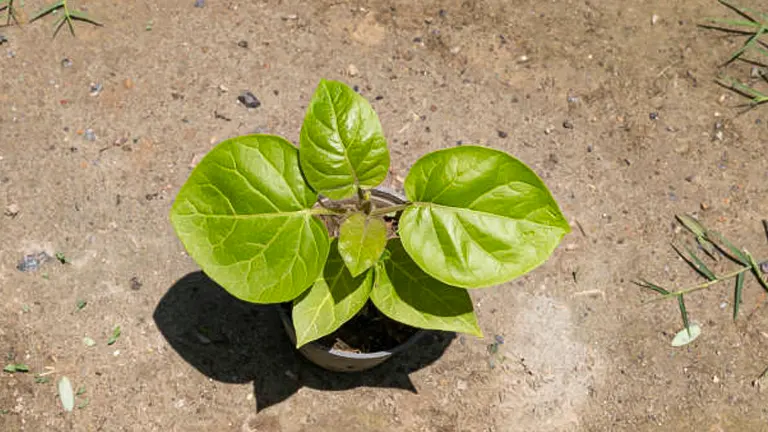
Proper watering is crucial for the health and productivity of tomatillo plants, particularly as they enter the fruiting stage. The goal is to maintain a balance where the soil remains moist but not waterlogged, encouraging healthy root and fruit development.
- Watering Depth and Frequency: Water the plants deeply to a depth of at least 6 inches, which encourages roots to grow deeper into the soil, making them more resilient during dry spells. During peak growing season, watering should be done early in the morning, ideally 2-3 times per week, depending on weather conditions. The soil should be allowed to dry out slightly between waterings to prevent root diseases.
- Monitoring Soil Moisture: Use a soil moisture meter or check manually by feeling the soil a few inches below the surface. If the top inch is dry, it’s time to water.
Here’s a table summarizing optimal watering strategies:
| Aspect | Recommendation |
|---|---|
| Watering Depth | 6 inches deep |
| Frequency | 2-3 times per week (adjust based on weather conditions) |
| Soil Moisture Check | Top inch should be dry before next watering |
Mulching and Weed Control
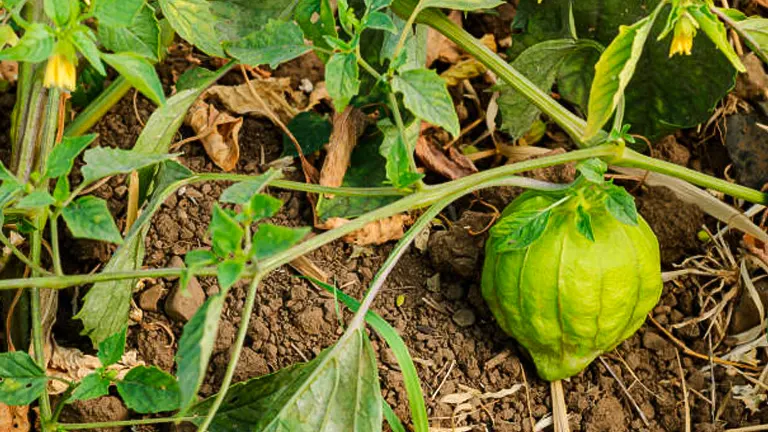
Mulching plays a dual role in maintaining moisture levels and suppressing weed growth, both critical for the health of tomatillo plants.
- Types of Mulch: Organic mulches like straw, shredded leaves, or grass clippings are best. They not only suppress weeds but also add nutrients back into the soil as they decompose.
- Application: Apply a 2 to 3-inch layer of mulch around the base of the plants, keeping it a few inches away from the stems to prevent potential rotting.
- Benefits: Mulch helps regulate soil temperature, keeps moisture levels consistent, and reduces the growth of weeds. Scientific studies have shown that mulching can reduce water evaporation from the soil by up to 50%, significantly reducing the need for frequent watering.
Weed Control
Regular weeding is crucial as weeds compete with tomatillo plants for nutrients and water, which can severely impact plant health and fruit yield.
- Weeding Techniques: Hand pulling is effective for removing weeds close to the plants to avoid root disturbance. For larger areas, a hoe can be used cautiously to remove weeds between rows.
- Frequency: Weeding should be done weekly to keep the garden bed clean and to prevent weeds from establishing and competing with the tomatillo plants.
Here’s a quick reference table for weed control practices:
| Method | Frequency | Note |
|---|---|---|
| Hand Pulling | As needed | Ideal for close proximity to plants |
| Hoeing | Weekly | Use between rows, avoid disturbing roots |
Pruning and Training
Pruning Techniques
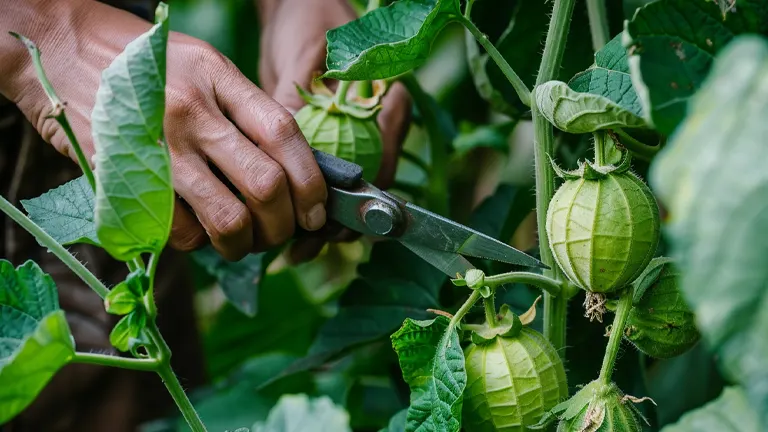
While tomatillos typically require less pruning than other fruits, strategic minimal pruning can optimize plant health and productivity. Here’s how to approach it:
- Selective Removal: Regularly inspect plants and remove any branches that are dead, diseased, or damaged. This helps prevent the spread of disease and encourages healthier fruit production.
- Thinning for Light and Air: If the plant becomes overly dense, selectively thin out some of the inner branches. This increases light penetration and air circulation around the fruits, reducing the risk of fungal diseases. Scientifically, better airflow has been correlated with a reduction in leaf wetness duration, a critical factor in the development of many plant diseases.
- Height Management: Limiting the height of the plant by trimming the top can encourage more lateral growth, making the plant bushier rather than taller. This method can facilitate easier harvesting and improve overall yield.
Here’s a table summarizing the pruning techniques:
| Technique | Purpose | Frequency |
|---|---|---|
| Selective Removal | Remove dead/diseased branches | As needed |
| Thinning | Improve light penetration and airflow | Mid-season |
| Height Management | Encourage bushier growth | Once per season |
Training Methods
Training tomatillos involves supporting their natural growth pattern to enhance fruit quality and ease of harvest:
- Support Structures: Use stakes, trellises, or cages to support tomatillo plants. Installing these supports early in the season is crucial to avoid disturbing the roots later. Supports help keep the fruits off the ground, significantly reducing the risk of soil-borne diseases and pest attacks.
- Tying Technique: Use soft plant ties to gently secure tomatillo branches to the supports. Allow flexibility for growth, ensuring that ties are not too tight, which can restrict plant development and potentially damage the stem.
| Method | Tool | Benefit |
|---|---|---|
| Staking | Stakes, trellises | Reduces disease, improves fruit quality |
| Tying | Soft plant ties | Supports growth, avoids stem damage |
Pest and Disease Management
Common Pests and Diseases
Tomatillos are susceptible to several pests and diseases that can hinder their growth and fruit production. Common pests include aphids, flea beetles, and tomato hornworms. These pests not only damage the leaves but can also affect the overall health of the plant by transmitting diseases or weakening the plant’s vigor.
Diseases like early blight and powdery mildew are also prevalent. Early blight causes dark, concentrically ringed spots on leaves, while powdery mildew presents as a white powdery residue on the upper surface of leaves.
Organic and Chemical Treatment Options
- Organic methods: Neem oil and insecticidal soaps can be effective against aphids and other small insects. For larger pests like tomato hornworms, manual removal may be necessary.
- Chemical options: If pest pressure is high and organic methods are insufficient, targeted use of pesticides can be considered. Always choose products that are specifically labeled for use on tomatillos and follow the manufacturer’s instructions carefully.
Preventive Measures
Prevention is key to managing pests and diseases:
- Crop rotation: Avoid planting tomatillos or other nightshades in the same area consecutively to reduce disease carryover.
- Sanitation: Keep the area around the plants clean and free of plant debris to minimize the habitat for pests and disease.
- Healthy soil practices: Maintain soil health through the addition of compost and proper fertilization, which can help plants resist diseases.
Harvesting and Storing
Signs of Maturity
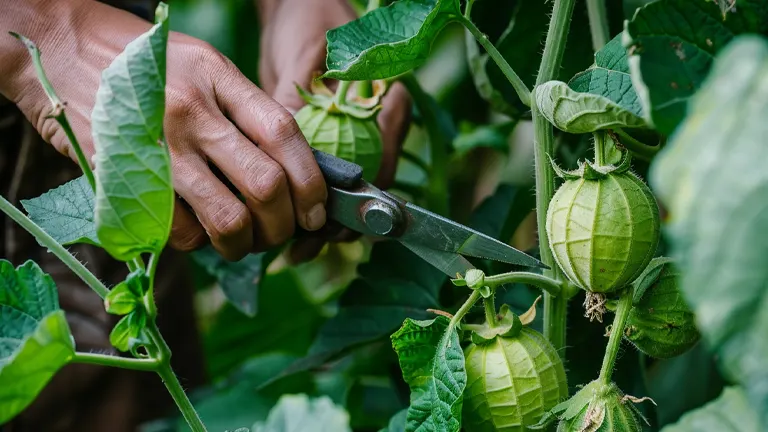
Tomatillos are ready to harvest when the fruits have filled the husk and the husk begins to split. The color of the fruit can also indicate ripeness; most tomatillos are ready when they are still green, though some varieties may turn yellow or purple.
Tips for Harvesting
- Gentle handling: Harvest tomatillos by cutting them from the vine with pruning shears to avoid damaging the plant.
- Regular harvesting: Frequent harvesting encourages the plant to produce more fruit throughout the growing season.
Post-Harvest Care
Once harvested, tomatillos can be stored in their husks at room temperature for about two weeks or in the refrigerator for up to a month. For longer storage, tomatillos can be frozen, canned, or dried.
- Preparing for storage: Remove the husks and wash the fruits to remove the sticky residue on the surface before storing.
- Freezing: Slice the tomatillos and spread them on a baking sheet to freeze individually before transferring to freezer bags. This prevents them from sticking together and allows for easy portioning.
Troubleshooting Common Issues
Growing tomatillos can sometimes present challenges, even to experienced gardeners. Here are some common issues and how to address them:
- Stunted Growth: If your tomatillos are not growing as expected, check for signs of nutrient deficiencies or root-bound plants. Ensure that the soil is rich in nutrients and the plants are not competing too closely with each other. Adjusting the spacing and applying a balanced fertilizer can help.
- Poor Fruit Set: Tomatillos require cross-pollination, so planting multiple plants is essential. If fruit set is poor, consider increasing the number of plants to ensure better pollination. Additionally, attracting pollinators such as bees can help improve fruit set.
- Sunscald: Direct, intense sunlight can sometimes damage the fruit. Use lightweight row covers or plant in locations that receive some afternoon shade to protect the fruits during the hottest parts of the day.
Environmental Stress Factors
Environmental factors can also impact the health and productivity of your tomatillo plants:
- Water Stress: Both underwatering and overwatering can cause problems. Maintain a consistent watering schedule and ensure the soil is well-draining to prevent waterlogging.
- Temperature Extremes: Tomatillos prefer warm, consistent temperatures. Protect plants from early frosts by covering them with frost cloths or plant covers. In extremely hot climates, shade cloths during the peak hours can prevent overheating.
Related Post
- How to Build a Barn: A Step-by-Step Guide for Beginners
- How to Build a Sustainable Compost Bin: Easy and Eco-Friendly DIY
- How to Fertilize Bougainvillea: A Complete Guide for Stunning Blooms
- How to Fertilize Apple Trees: Essential Tips for a Bountiful Harvest
- How to Fertilize Lemon Trees: Secrets for Thriving Citrus
- How to Fertilize Avocado Tree: A Step-by-Step Guide for Lush Growth
- 10 Best Bow Saws to Buy in 2024: Top Picks for the Money
- Best Miter Saw For Beginners
- Top 10 Pruning Saws to Buy in 2024: Best for the Money
- 7 Best Pocket Chainsaw
Conclusion
Growing tomatillos is a gratifying endeavor that adds unique flavors to your dishes and diversity to your garden. By following the expert tips and tricks outlined in this guide—from selecting the right varieties and understanding their care needs to managing pests and diseases—you can ensure a healthy and productive tomatillo crop. Remember, the key to successful gardening is observation and adaptation; monitor your plants regularly and adjust your care practices as needed to address any issues that arise.
FAQs
- What is the best way to ensure tomatillos pollinate successfully?
Tomatillos require cross-pollination to produce fruit, which means having at least two tomatillo plants is crucial. Planting several tomatillos close together increases the chances of pollination by bees and other pollinators. Additionally, you can gently shake the flowering stems to help distribute pollen. - Can tomatillos be grown in containers?
Yes, tomatillos can thrive in containers as long as they are large enough to accommodate the plant’s root system. A pot with a diameter of at least 24 inches is recommended. Ensure the container has good drainage and use a high-quality potting mix enriched with compost. - How often should I water my tomatillo plants?
Water tomatillo plants deeply once a week, or more frequently during hot, dry weather. The goal is to keep the soil consistently moist but not waterlogged. Check the top inch of soil; if it feels dry, it’s time to water. - When is the right time to harvest tomatillos?
Harvest tomatillos when the husks are green and have split, or the fruit fills the husk and it begins to open. The fruit should be firm and fully colored, depending on the variety. If left too long, the fruit may fall off the plant. - Do tomatillos have any specific fertilizer requirements?
Tomatillos benefit from fertilization similar to tomatoes. Apply a balanced fertilizer (like a 10-10-10 NPK) at planting and again as fruits begin to form. Avoid high nitrogen fertilizers late in the growing season as they can promote leaf growth over fruit production. - What are some effective ways to manage pests on tomatillo plants?
Regularly inspect plants for signs of pests and manage them early. Use organic options like neem oil or insecticidal soap for aphids and other small insects. For larger pests like the tomato hornworm, manually remove them from the plants. Employing floating row covers can also prevent pests from reaching the plants. - How can I store tomatillos for the long term?
For long-term storage, tomatillos can be kept in a cool, dark place where they will last for about 2-3 weeks. For extended storage, they can be frozen, canned, or dried. To freeze, remove husks, wash and dry the fruits, then slice and spread on a baking sheet to freeze individually before transferring to freezer bags. - Can tomatillos be grown in partial shade?
While tomatillos prefer full sun, they can tolerate partial shade, particularly in hot climates. However, too much shade may reduce yield and fruit size. Ensure they receive at least 6 hours of direct sunlight daily for optimal growth.
With these expert tips and tricks, you’re now equipped to start your tomatillo garden. Enjoy the process, and look forward to the tasty, home-grown tomatillos that will soon be a highlight of your culinary creations. Happy gardening!

Benjamin Brooks
Forestry AuthorGreetings! I'm Benjamin Brooks, and my journey over the past 15 years has revolved around the fascinating realms of content creation, expertise in snow clearing, and the intricate world of lumberjacking and landscaping. What began as a simple curiosity about the natural world and heavy machinery has evolved into a passionate profession where my love for crafting words intertwines seamlessly with my lumberjacking and garden skills.




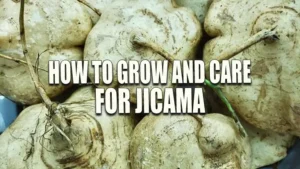




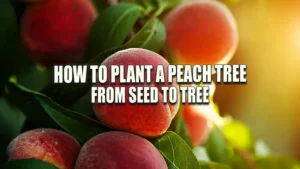

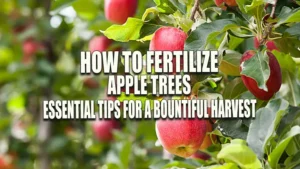
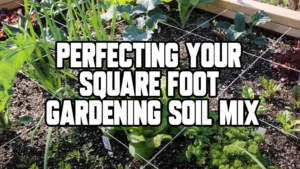
Leave your comment